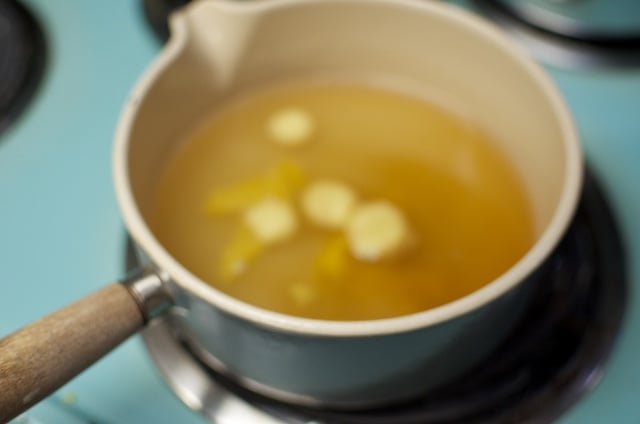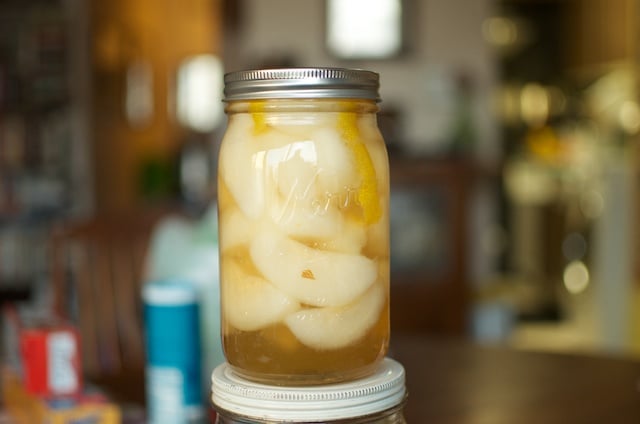
Asian pears are a tough ingredient for preservers. So much of their charm is in their clean flavor and snappy texture and those are qualities that don’t translate well in a jam or butter. They’re also really quite low in acid and so have be to acidified aggressively in order to be safe for canning. Sometime ago, I determined to save myself the heartache of wasted asian pears and simply kept them far away from my jars.

But then, I got a copy of Karen Solomon’s new e-book, called Asian Pickles. Her publisher is doing this brilliant thing, in which they’re releasing sections of the book electronically in advance of the physical publication. These e-versions include audio enhancements and give you a chance to preview some of the content that the print edition will include.

Included in this lovely little e-book was a recipe for Pickled Asian Pear with Lemon. You lightly poach asian pear wedges and then float them in a brine made from white wine vinegar, sugar, and lemon juice. Strips of lemon zest and slivers of ginger add flavor (the recipe calls for pickled ginger, but not having any in my kitchen, I substituted a few peeled slices of fresh).

This recipe neatly dealt with all my asian pear preserving issues. It handles the acid issue with a generous application of undiluted vinegar. You do lose the crunch of the raw pear, but in its place is a silky, tender portion of fruit. I’ve taken to eating bits of these pickles pears with blue cheese over torn Bibb lettuce. With persimmons slowly fading from the seasonal fruit array, I’m happy to have a different fruit to heap onto my lunchtime salads.

You should know that Karen’s e-book isn’t simply easy little pickles like this one (though there are others that can be made with relative quickness). She goes into a great, useful depth about traditional Japanese pickling and offers details about the various techniques (including how to start and maintain a pickling bed), carefully explains the steps required to pull off the trickier ferments, and offers lots of helpful suggestions about how to incorporate these new-to-you pickles into your meals. For $2.99, it’s a serious score.

Pickled Asian Pears with Lemon
Ingredients
- 2 pounds Asian pears or any other sweet, firm pear (3-4 pears)
- 4 2-inch pieces of lemon zest
- Juice of 1 lemon
- 4 slices pickled ginger or several slices of fresh ginger if you don’t have pickled
- 11 ⁄2 cups sugar
- 11 ⁄2 teaspoons kosher salt
- 1 cup white wine vinegar
- 2 tablespoons mirin
Instructions
- Select pears that are firm and on the small side. Peel them, cut them into quarters, and core them.
- Combine the lemon zest, lemon juice, ginger, sugar, salt, vinegar, and mirin in a medium nonreactive saucepan off-heat; don’t worry that the sugar is not yet dissolved.
- Add the cut pears to the pan to coat them in the acidic brine.
- Meanwhile, fill a second medium saucepan with water and bring it to a simmer.
- Using a slotted spoon, transfer the pears to the simmering water, leaving behind as much of the brine as possible.
- Simmer the pears until they turn white and are just cooked through but still quite firm, about 6 minutes.
- The pears should be pierced easily with a fork, but you don’t want them to overcook and get mushy.
- Drain the pears and transfer them to 2 clean pint jars (I used a single quart jar), packing them tightly and tucking them under the curved “shoulders” of the jar.
- Bring the brine pot to a boil, uncovered, stirring to dissolve the sugar, about 2 minutes.
- Once it’s boiling, turn off the heat. Divide the ginger and lemon zest between the two jars.
- Pour the brine over the pears in the jars to cover completely (reserve the leftover brine).
- Tighten the lids on the jars immediately and let them rest on the countertop for 1 day before moving them to the refrigerator.
- The pears are ready to eat in 3 days, but taste even better after 5.
- They will keep their flavor for about a month in the refrigerator, but the color will begin to change after 2 weeks.

Love this recipe! The results are delicious! Wondering if putting the packed sealed jars in a water bath for 20 minutes would improve their shelf stability?
You could process them, but it would significantly soften the texture of the pears.
I made these this week using my Chojuro Asian Pears. I wanted to can them, so I peeled and chopped into ~1×1″ pieces, then soaked briefly in the brine and cold packed into jars. Heated the brine and boiled 2 minutes, then filled jars and processed in a boiling water bath for 15 minutes. The resulting pieces still have a nice texture (not mushy) and the flavor is pleasantly sweet-tart, with a ginger kick.
Thank you for sharing your process! Sounds delicious!
These are delicious and unique!
So glad you like them!
I made these last week and love them. Do you have any suggestions on using the brine that is left. I really like it and don’t want to just throw it out. Thank you. I love your books and use them often.
It’s great as part of a salad dressing!
I tried this recipe and it came out great! My 1st try at pickling.
Hooray!
Would you cook the pears in the brine? Rather than a poach and then back into the brine? Eliminate one step?
I made one batch and also added bay leaf as we have a very big tree here and trying to use more in our cooking and preserving.
That’s certainly an option.
I was fortunate enough to meet Karen in November at a book party for a mutual friend. She brought these pickles to the potluck, and we all went bananas. They really are amazing.
Oh these look tasty, and I’ve been trying to figure out some Asian pickles. Thanks for the link to the eBook! I feel like I have a new goldmine of recipes 🙂
Thank you for letting us know about the book. My mother and I make Umeboshi every year with a variety of flavors. She grew shiso last year, and instead of ume plums we use almost ripe apricots because those are plentiful around here. My mother, being japanese, makes all sorts of pickles thru out the year depending on what veggies are available. This is will a nice surprise for her when I bring her my very own japanese pickles to her home. I usually make american style pickles and take them to her. As for the Asian pear recipe, we have 3 trees that all come on super fast in the early fall, so I have to give it a try. We usually just wash the pears, dry them then wrap them individually in a papertowel and place them in a ziploc or container with lid. The neighbors love our pears. This year we were still eating pears in December. Thanks for all your wonderful posts and for your awesome book, I have really enjoyed it.
I love Asian pears. What a fun new way to eat them!
I will have to try this. We have two asian pear trees and I spend the end of the season slicing and drying as many as I can. I love them dried, but it will be great to have another option.
Dried Asian pears? How interesting! Do you dry them in the oven or a dryer?
I use a dryer. I slice them to about 3mm and then put them in a lemon juice and cold water bath for 10 -15 minutes. They are my favorite winter snack!
I was just telling someone I should learn how to make umeboshi plums, so it sounds like I should check this out!
You definitely should!
What would your thought be on waterbath canning these? Do you think it would work or would they turn to mush (my disappointed suspicion)?
In the book, Karen says that you could water bath can them. I left them as refrigerator pickles because I was fearful for their texture. Maybe you could compensate by poaching them less?